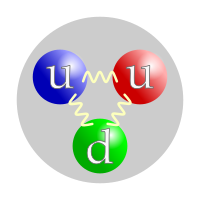
Photo from wikipedia
We use a method to calculate the hadron's charge radius without model-dependent momentum extrapolations. The method does not require the additional quark propagator inversions on the twisted boundary conditions or… Click to show full abstract
We use a method to calculate the hadron's charge radius without model-dependent momentum extrapolations. The method does not require the additional quark propagator inversions on the twisted boundary conditions or the computation of the momentum derivatives of quark propagators and thus is easy to implement. We apply this method to the calculation of pion charge radius $\langle r_\pi^2\rangle$. For comparison, we also determine $\langle r_\pi^2\rangle$ with the traditional approach of computing the slope of the form factors. The new method produces results consistent with those from the traditional method and with statistical errors 1.5-1.9 times smaller. For the four gauge ensembles at the physical pion masses, the statistical errors of $\langle r_\pi^2\rangle$ range from 2.1% to 4.6% by using $\lesssim50$ configurations. For the ensemble at $m_\pi\approx 340$ MeV, the statistical uncertainty is even reduced to a sub-percent level.
Journal Title: Physical Review D
Year Published: 2020
Link to full text (if available)
Share on Social Media: Sign Up to like & get
recommendations!